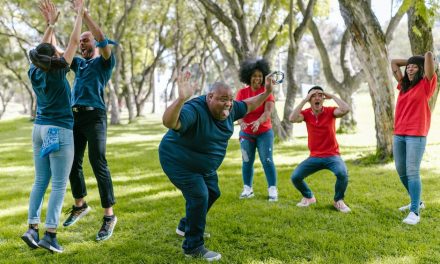Table of Contents
- Introduction
- The Benefits of Collaborative Learning in Developing 21st Century Skills
- Strategies for Implementing Collaborative Learning in the Classroom
- How Collaborative Learning Enhances Critical Thinking and Problem-Solving Skills
- Collaborative Learning: Fostering Communication and Collaboration Skills for the Future
- Q&A
- Conclusion
Unlock Your Potential with Collaborative Learning
Introduction
Collaborative learning is an educational approach that emphasizes the importance of students working together in groups to achieve common learning goals. It is considered a key strategy for developing 21st-century skills, which are essential for success in today’s rapidly changing world. This approach encourages active participation, critical thinking, problem-solving, communication, and teamwork among students. By engaging in collaborative learning activities, students not only acquire knowledge but also develop important skills that are highly valued in the 21st century workplace.
The Benefits of Collaborative Learning in Developing 21st Century Skills

Collaborative learning has become increasingly popular in educational settings as educators recognize its potential to develop 21st century skills in students. In today’s rapidly changing world, it is crucial for students to possess skills such as critical thinking, problem-solving, communication, and collaboration. Collaborative learning provides a platform for students to develop and enhance these skills through active engagement with their peers.
One of the key benefits of collaborative learning is the opportunity for students to develop critical thinking skills. When working in groups, students are exposed to different perspectives and ideas, which challenges their own thinking and encourages them to think critically. They learn to analyze information, evaluate different viewpoints, and make informed decisions. This process of critical thinking is essential in the 21st century, where information is abundant and constantly evolving.
Collaborative learning also promotes problem-solving skills. In a group setting, students are presented with various problems or tasks that require them to work together to find solutions. They learn to brainstorm ideas, consider different approaches, and evaluate the effectiveness of their solutions. Through this process, students develop their problem-solving skills, which are highly valued in the 21st century workplace.
Furthermore, collaborative learning enhances communication skills. In group discussions and projects, students are required to express their ideas, listen to others, and engage in meaningful dialogue. They learn to articulate their thoughts clearly, ask questions, and actively listen to their peers. These communication skills are essential in the 21st century, where effective communication is crucial in both personal and professional settings.
Collaborative learning also fosters collaboration skills. Students learn to work together towards a common goal, share responsibilities, and contribute to the success of the group. They develop skills such as teamwork, cooperation, and compromise. In the 21st century, collaboration is highly valued as it promotes innovation, creativity, and productivity. By engaging in collaborative learning, students are better prepared for future collaborative endeavors.
In addition to developing specific skills, collaborative learning also has broader benefits. It promotes a positive learning environment where students feel supported and valued. They learn to respect and appreciate the contributions of their peers, fostering a sense of community and belonging. This positive learning environment enhances motivation and engagement, leading to improved academic performance.
Moreover, collaborative learning prepares students for the realities of the 21st century workforce. In today’s globalized and interconnected world, most jobs require individuals to work in teams and collaborate with colleagues from diverse backgrounds. By engaging in collaborative learning, students gain experience in working with others, understanding different perspectives, and adapting to different working styles. These skills are highly transferable and valuable in the professional world.
In conclusion, collaborative learning is a powerful tool for developing 21st century skills in students. It provides opportunities for students to develop critical thinking, problem-solving, communication, and collaboration skills. Additionally, it promotes a positive learning environment and prepares students for the realities of the 21st century workforce. As educators strive to prepare students for the challenges and opportunities of the future, collaborative learning should be embraced as a key pedagogical approach.
Strategies for Implementing Collaborative Learning in the Classroom
Collaborative learning has become increasingly recognized as a powerful tool for developing 21st century skills in students. By working together in groups, students are able to enhance their critical thinking, communication, and problem-solving abilities. However, implementing collaborative learning in the classroom can be a challenge for educators. In this section, we will explore some strategies that can help teachers effectively incorporate collaborative learning into their teaching practices.
One strategy for implementing collaborative learning is to establish clear expectations and guidelines for group work. This includes defining roles and responsibilities for each group member, as well as setting guidelines for how groups should communicate and make decisions. By providing students with a clear structure, teachers can ensure that group work is productive and focused.
Another strategy is to create a supportive and inclusive classroom environment. This can be achieved by fostering a sense of community and trust among students. Teachers can encourage collaboration by promoting positive interactions and emphasizing the importance of teamwork. By creating a safe and welcoming space, students will feel more comfortable sharing their ideas and working together.
In addition, teachers can provide students with the necessary tools and resources to support their collaborative learning. This includes access to technology, such as laptops or tablets, as well as relevant materials and resources. By equipping students with the right tools, teachers can enhance their ability to collaborate effectively and efficiently.
Furthermore, teachers can facilitate collaborative learning by incorporating various instructional strategies into their lessons. For example, they can use group discussions, problem-solving activities, and project-based learning to encourage collaboration among students. By engaging students in hands-on and interactive activities, teachers can promote active learning and foster collaboration.
Moreover, teachers can also play an active role in facilitating group work. This includes providing guidance and support to students as they work together. Teachers can offer feedback and suggestions, as well as help students navigate challenges and conflicts that may arise during group work. By acting as a facilitator, teachers can ensure that group work is productive and beneficial for all students involved.
Additionally, teachers can assess and evaluate students’ collaborative skills. This can be done through various methods, such as observing group interactions, reviewing group projects, or conducting peer evaluations. By assessing students’ collaborative skills, teachers can provide feedback and identify areas for improvement. This feedback can then be used to guide future instruction and support students’ ongoing development of 21st century skills.
In conclusion, implementing collaborative learning in the classroom requires careful planning and consideration. By establishing clear expectations, creating a supportive environment, providing necessary tools and resources, incorporating instructional strategies, facilitating group work, and assessing students’ collaborative skills, teachers can effectively incorporate collaborative learning into their teaching practices. By doing so, they can help students develop the 21st century skills they need to succeed in an increasingly interconnected and collaborative world.
How Collaborative Learning Enhances Critical Thinking and Problem-Solving Skills
Collaborative learning has become increasingly popular in educational settings as educators recognize its potential to enhance critical thinking and problem-solving skills. In the 21st century, these skills are highly valued and sought after by employers, making collaborative learning an essential component of preparing students for the workforce.
One of the key ways in which collaborative learning enhances critical thinking and problem-solving skills is through the exchange of ideas and perspectives. When students work together in groups, they are exposed to a variety of viewpoints and approaches to problem-solving. This exposure challenges their own thinking and encourages them to consider alternative solutions. By engaging in discussions and debates with their peers, students learn to critically evaluate different ideas and develop their own informed opinions.
Furthermore, collaborative learning provides students with the opportunity to practice and refine their communication skills. Effective communication is crucial for problem-solving, as it allows individuals to articulate their thoughts and ideas clearly and concisely. Through collaborative learning, students learn to express their opinions, listen actively to others, and engage in constructive dialogue. These communication skills are not only valuable in academic settings but also in professional environments where teamwork and collaboration are essential.
In addition to enhancing critical thinking and communication skills, collaborative learning also fosters creativity and innovation. When students work together, they are encouraged to think outside the box and come up with innovative solutions to problems. By brainstorming ideas collectively, students can build upon each other’s ideas and create new and unique approaches. This collaborative process stimulates creativity and encourages students to take risks and explore unconventional solutions.
Moreover, collaborative learning provides students with the opportunity to develop important social and emotional skills. Working in groups requires individuals to cooperate, compromise, and resolve conflicts. Through these interactions, students learn to navigate interpersonal relationships, develop empathy, and build trust. These social and emotional skills are not only crucial for effective collaboration but also for success in the 21st century workplace, where teamwork and interpersonal skills are highly valued.
Research has consistently shown that collaborative learning leads to improved academic performance. When students work together, they are more engaged and motivated, leading to a deeper understanding of the subject matter. Collaborative learning also promotes active learning, as students are actively involved in the learning process rather than passively receiving information. This active engagement enhances retention and comprehension of the material, ultimately leading to better academic outcomes.
In conclusion, collaborative learning is a powerful tool for developing critical thinking and problem-solving skills in the 21st century. Through the exchange of ideas, students learn to critically evaluate different perspectives and develop their own informed opinions. Collaborative learning also enhances communication skills, fosters creativity and innovation, and promotes the development of important social and emotional skills. By incorporating collaborative learning into educational settings, educators can better prepare students for the challenges and opportunities of the 21st century workforce.
Collaborative Learning: Fostering Communication and Collaboration Skills for the Future
Collaborative learning has become increasingly important in today’s educational landscape as it fosters the development of essential 21st-century skills. In a world that is becoming more interconnected and reliant on teamwork, it is crucial for students to learn how to effectively communicate and collaborate with others. This article will explore the benefits of collaborative learning and how it can help students develop these vital skills.
One of the primary advantages of collaborative learning is that it encourages active participation and engagement among students. Instead of passively receiving information from a teacher, students are actively involved in the learning process. They work together in groups, discussing ideas, solving problems, and sharing their knowledge. This active engagement promotes a deeper understanding of the subject matter and enhances critical thinking skills.
Collaborative learning also helps students develop effective communication skills. In group settings, students must articulate their thoughts and ideas clearly and concisely. They learn how to listen actively to their peers, ask questions, and provide constructive feedback. These communication skills are essential in the 21st century, where effective communication is crucial in both personal and professional settings.
Furthermore, collaborative learning fosters the development of teamwork and collaboration skills. Students learn how to work together towards a common goal, negotiate and compromise, and leverage each other’s strengths. These skills are highly valued in the workplace, where teamwork and collaboration are essential for success. By engaging in collaborative learning activities, students gain practical experience in working effectively with others, preparing them for future professional endeavors.
In addition to communication and collaboration skills, collaborative learning also promotes the development of other 21st-century skills, such as problem-solving, creativity, and adaptability. When students work together in groups, they encounter a variety of perspectives and ideas. This diversity of thought stimulates creativity and encourages students to think outside the box. Collaborative learning also presents students with real-world problems and challenges, allowing them to apply their knowledge and skills in practical ways. This problem-solving experience prepares students to tackle complex issues they may encounter in their future careers.
Moreover, collaborative learning provides students with opportunities to develop their digital literacy skills. In today’s digital age, it is crucial for students to be proficient in using technology for communication and collaboration. Collaborative learning often involves the use of online platforms, such as discussion boards or shared documents, where students can collaborate remotely. By engaging in these digital tools, students become familiar with technology and develop the skills necessary to navigate and utilize digital resources effectively.
In conclusion, collaborative learning is a powerful tool for developing 21st-century skills. It fosters communication and collaboration skills, promotes active engagement and critical thinking, and enhances problem-solving, creativity, and adaptability. By engaging in collaborative learning activities, students gain practical experience in working effectively with others and develop the skills necessary for success in the future. As educators, it is essential to incorporate collaborative learning strategies into our classrooms to prepare students for the challenges and opportunities of the 21st century.
Q&A
1. What is collaborative learning?
Collaborative learning is an educational approach where students work together in groups to solve problems, complete tasks, or learn new concepts.
2. Why is collaborative learning important?
Collaborative learning promotes the development of 21st-century skills such as communication, critical thinking, problem-solving, and teamwork. It also enhances social interaction and helps students learn from each other’s perspectives.
3. How does collaborative learning benefit students?
Collaborative learning encourages active engagement, improves retention of information, and fosters a deeper understanding of the subject matter. It also enhances students’ ability to work in diverse teams and prepares them for real-world challenges.
4. What are some strategies for implementing collaborative learning?
Strategies for implementing collaborative learning include assigning group projects, facilitating discussions, using technology tools for collaboration, providing clear guidelines and roles, and promoting a positive and inclusive learning environment.
Conclusion
Collaborative learning is essential for developing 21st-century skills. It promotes active engagement, critical thinking, problem-solving, communication, and teamwork among learners. By working together, students can gain a deeper understanding of concepts, develop empathy, and enhance their ability to adapt to diverse perspectives. Collaborative learning also prepares individuals for the demands of the modern workforce, where collaboration and cooperation are highly valued. Overall, incorporating collaborative learning strategies in education is crucial for equipping students with the necessary skills to thrive in the 21st century.





Recent Comments